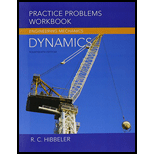
Concept explainers
Determine the work of the force when it displaces 2 m.
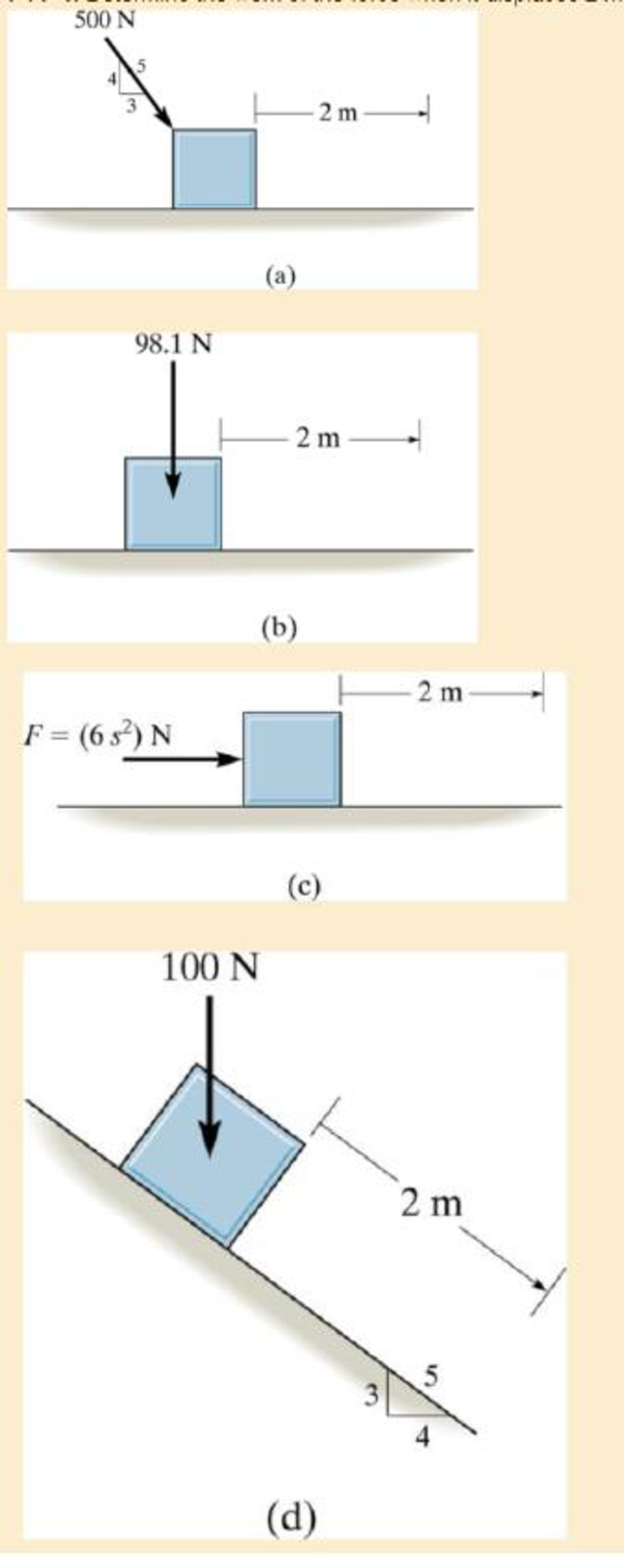
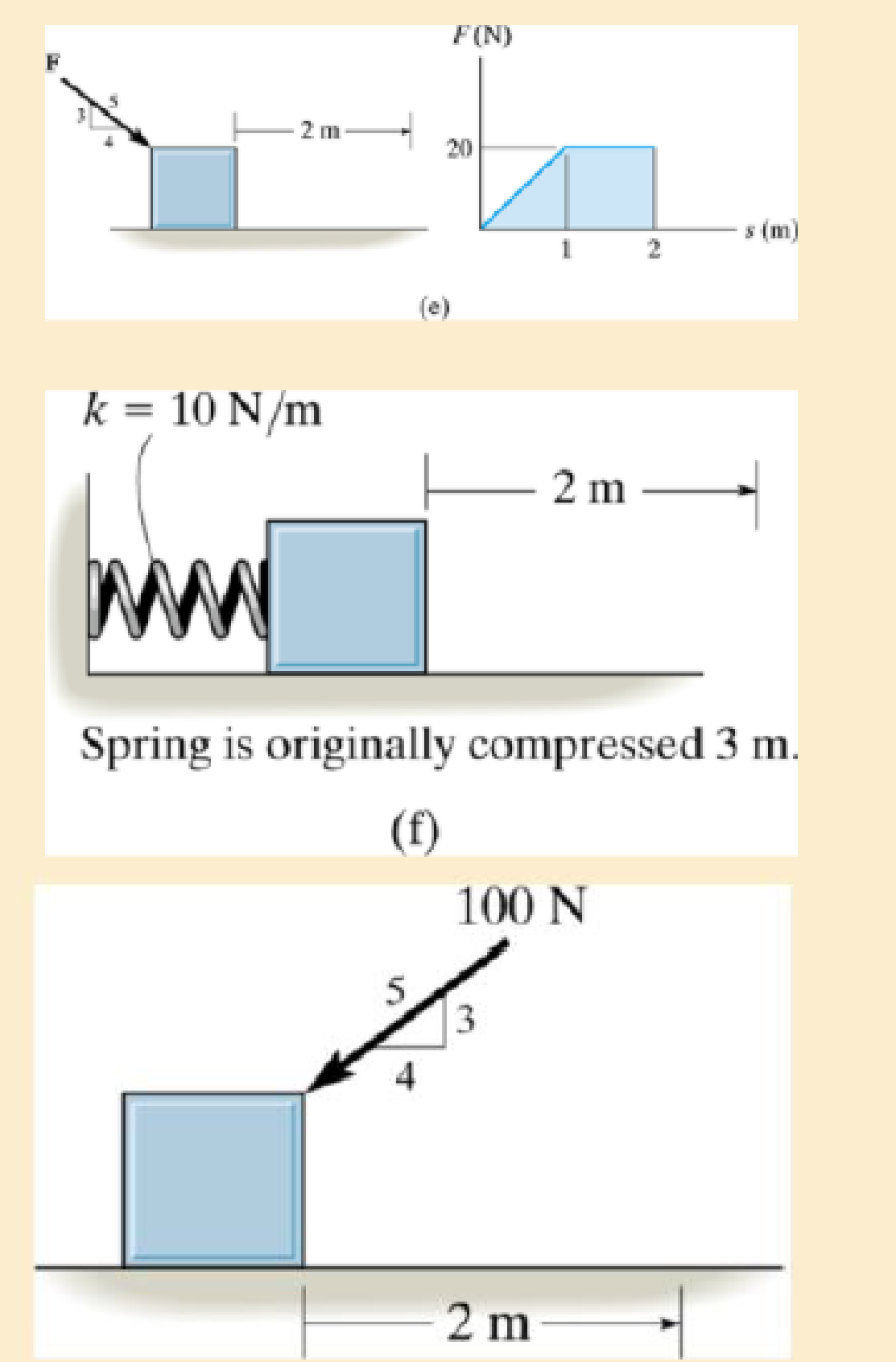
a)
The work of a force.
Answer to Problem 1PP
The work done by the force on the block is
Explanation of Solution
Given:
The force acting on the block is
The displacement of the block is
Draw the free body diagram of block as shown in Figure (a).

Write the formula for work done force
Here,
Conclusion:
Refer Figure (a).
Resolve the force along
Substitute
Thus, the work done by the force on the block is
b)
The work of a force.
Answer to Problem 1PP
The work done by the force on the block is
Explanation of Solution
Given:
The force acting on the block is
The displacement of the block is
Draw the free body diagram of block as shown in Figure (b).

Write the formula for work done force
Here,
Conclusion:
Refer Figure (1).
The force acting on the block does not cause any displacement of the block. Hence the work done by the force is zero.
Thus, the work done by the force on the block is
c)
The work of a force.
Answer to Problem 1PP
The work done by the force on the block is
Explanation of Solution
Given:
The force acting on the block is
The displacement of the block is
Draw the free body diagram of block as shown in Figure (c).

Write the formula for work done force
Here,
Conclusion:
Refer Figure (c).
Substitute
Thus, the work done by the force on the block is
d)
The work of a force.
Answer to Problem 1PP
The work done by the force on the block is
Explanation of Solution
Given:
The force acting on the block is
The displacement of the block is
Draw the free body diagram of block as shown in Figure (d).

Write the formula for work done force
Here,
Conclusion:
Refer Figure (d).
Resolve the force along
Substitute
Thus, the work done by the force on the block is
e)
The work of a force.
Answer to Problem 1PP
The work done by the force on the block is
Explanation of Solution
Given:
The displacement of the block is
The given
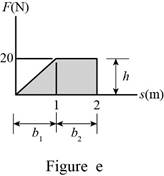
Draw the free body diagram of block as shown in Figure (1e).
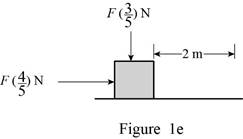
The graph consists of two geometrical cross sectional areas namely triangle and rectangle.
Write the formula for work done force
Here,
Refer Figure (e).
Write the formula for triangle.
Write the formula for rectangle.
Conclusion:
Refer Figure (e).
Calculate the area under the
Substitute
Substitute
Calculate the work done by the force
Substitute
Thus, the work done by the force on the block is
f)
The work of a spring force.
Answer to Problem 1PP
The work done by the force on the block is
Explanation of Solution
Given:
The stiffness of the spring is
The spring is originally compressed to
Draw the free body diagram of block as shown in Figure (f).
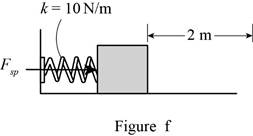
Write the formula for work done force
Here,
Conclusion:
Refer Figure (f).
Here, the block is subjected to spring force only.
When the spring is originally compressed to
When the spring is released, the displaced to
Substitute
Thus, the work done by the spring force on the block is
g)
The work of a force.
Answer to Problem 1PP
The work done by the force on the block is
Explanation of Solution
Given:
The force acting on the block is
The displacement of the block is
Draw the free body diagram of block as shown in Figure (g).
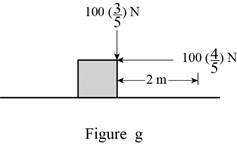
Write the formula for work done force
Here,
Conclusion:
Refer Figure (g).
Resolve the force along
Substitute
Thus, the work done by the force on the block is
Want to see more full solutions like this?
Chapter 14 Solutions
Practice Problems Workbook For Engineering Mechanics
- A roller coaster car has a mass of 600 kg when fully loaded with passengers. If the car has a speed of 20 m/sec at point A, what is the maximum speed the car can have at B and still remain on the track?arrow_forwardThe 10-lb collar starts from rest at A and is lifted by applying a constant vertical force of F = 25 lb to the cord. Part A: If the rod is smooth, determine the power developed by the force at the instant θ = 60 degressarrow_forwardThe 600-kg bar B, originally at rest, is towed over a series of small rollers. The motor M is drawing in the cable at a rate of v = (0.3 t2) m/s, where t is in seconds. Determine the force in the cable when t = 2 sarrow_forward
- Determine the potential energy of the block that has a weight of 100 N.arrow_forwardThe 5-oz pinewood-derby car is released from restat the starting line A and crosses the fi nish lineC 2.75 sec later. The transition at B is small andsmooth. Assume that the net retarding force is constant throughout the run and find this forcearrow_forward(Solution needed) 4. Two cars A and B are travelling in the same direction at SLEX. Car A is traveling at a constant velocity of 60 m/s while car B at 70 m/s. Find the distance between them 10s after the instant that they are 100 m apart. (Needs a solution)arrow_forward
- If the 40 kg skier passes point A with a speed of 2 m/s, determine his speed when he reaches point B. Also find the normal force exerted on him by the slope at this point. Neglect friction.arrow_forwardThe 100-kg crate is hoisted by the motor M. If the velocity of the crate increases uniformly from 1.5 m/s to 4.5 m/s in 5 s, determine the tension developed in the cable during the motionarrow_forwardThe 0.8-Mg car travels over the hill having the shape of a parabola. If the driver maintains a constant speed of 9 m/s, determine both the resultant normal force and the resultant frictional force that all the wheels of the car exert on the road at the instant it reaches point A. Neglect the size of the car.arrow_forward
- The 50-lb crate is subjected to the force F = 40 lb. The coefficient of kinetic friction between the crate and the ground is µk = 0.2. If the crate is initially moving to the right with a velocity of 3 ft/s, determine A) The speed of the block when t = 8 s. B) The power developed by force F at t = 8 s.arrow_forward. The 2.5-Mg four-wheel-drive SUV tows the 1.5-Mg trailer. The traction force developed at the wheels is FD = 9 kN. Determine the speed of the truck in 20 s, starting from rest. Also, determine the tension developed in the coupling, A, between the SUV and the trailer. Neglect the mass of the wheelarrow_forwardA 3.00 kg block slides on a semicircular track as shown. If it starts from rest at point A, determine the following a) potential energy at A b) kinetic energy and velocity at B c) potential energy, kinetic energy, and velocity at C.arrow_forward
 Elements Of ElectromagneticsMechanical EngineeringISBN:9780190698614Author:Sadiku, Matthew N. O.Publisher:Oxford University Press
Elements Of ElectromagneticsMechanical EngineeringISBN:9780190698614Author:Sadiku, Matthew N. O.Publisher:Oxford University Press Mechanics of Materials (10th Edition)Mechanical EngineeringISBN:9780134319650Author:Russell C. HibbelerPublisher:PEARSON
Mechanics of Materials (10th Edition)Mechanical EngineeringISBN:9780134319650Author:Russell C. HibbelerPublisher:PEARSON Thermodynamics: An Engineering ApproachMechanical EngineeringISBN:9781259822674Author:Yunus A. Cengel Dr., Michael A. BolesPublisher:McGraw-Hill Education
Thermodynamics: An Engineering ApproachMechanical EngineeringISBN:9781259822674Author:Yunus A. Cengel Dr., Michael A. BolesPublisher:McGraw-Hill Education Control Systems EngineeringMechanical EngineeringISBN:9781118170519Author:Norman S. NisePublisher:WILEY
Control Systems EngineeringMechanical EngineeringISBN:9781118170519Author:Norman S. NisePublisher:WILEY Mechanics of Materials (MindTap Course List)Mechanical EngineeringISBN:9781337093347Author:Barry J. Goodno, James M. GerePublisher:Cengage Learning
Mechanics of Materials (MindTap Course List)Mechanical EngineeringISBN:9781337093347Author:Barry J. Goodno, James M. GerePublisher:Cengage Learning Engineering Mechanics: StaticsMechanical EngineeringISBN:9781118807330Author:James L. Meriam, L. G. Kraige, J. N. BoltonPublisher:WILEY
Engineering Mechanics: StaticsMechanical EngineeringISBN:9781118807330Author:James L. Meriam, L. G. Kraige, J. N. BoltonPublisher:WILEY





